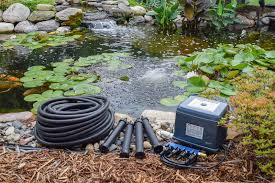Fall Water Quality: Managing Oxygen and Temperature Changes
Fall brings dramatic shifts in your pond's water chemistry as temperatures fluctuate and organic matter accumulates. Understanding these changes helps you maintain optimal water conditions during this transitional period.
The Oxygen-Temperature Challenge
Warm water holds significantly less dissolved oxygen than cold water, creating a dangerous paradox during late summer: fish are most active (requiring more oxygen) precisely when water can hold the least. This makes fall water quality management critical for fish health.
Recognizing Oxygen Stress
Watch your fish for these warning signs of oxygen depletion:
- Gasping at the water surface
- Clustering near waterfalls or fountains
- Lethargy or unusual behavior
- Increased susceptibility to disease
Temperature Fluctuation Management
Fall's daily temperature swings can stress your entire pond ecosystem. Large temperature changes within 24 hours shock fish and disrupt beneficial bacteria populations. Monitor these fluctuations and be prepared to intervene during extreme weather periods.
Aeration Solutions
Supplemental aeration becomes essential during fall's warm periods. Consider upgrading your circulation system with energy-efficient solutions like the Atlantic mini aeration kit, which provide reliable water movement while keeping operating costs manageable.
Effective Aeration Options:
- Fountain systems for surface agitation
- Waterfall circulation for natural oxygenation
- Dedicated aerators for deep water movement
Monitoring Water Parameters
Regular testing becomes more important as conditions change rapidly. Focus on:
- Dissolved oxygen levels (especially during warm spells)
- Ammonia and nitrite (increased from organic decomposition)
- pH stability (affected by decomposing plant matter)
- Water temperature trends
The Bacterial Connection
Healthy beneficial bacteria populations help stabilize water chemistry during seasonal transitions. These microscopic workers process organic waste that would otherwise deplete oxygen and create toxic conditions.
Quick Action Steps:
- Test water weekly during temperature transitions
- Increase aeration during warm fall days
- Remove organic debris promptly
- Monitor fish behavior for stress indicators
- Maintain beneficial bacteria populations
Want comprehensive fall preparation strategies? Explore our complete autumn pond care guide for detailed equipment maintenance, fish feeding schedules, plant winterization, and debris management techniques that ensure your entire pond ecosystem transitions successfully into winter.

